How to take care of your tires: Do’s and don’ts to give them more useful life

Take care of your tires It is a habit that all drivers should practice. Although tires are often overlooked, they are arguably the most important component of your vehicle. After all, tires are what keep you and your car on the road.
The main functions of car tires include supporting the vehicle’s load, transmitting traction and braking forces to the road surface, absorbing road shocks, and changing and maintaining direction of travel.
To ensure that these functions are implemented correctly, you must Take care of your tires And regularly check some important things about your tires, including tread depth, wear, air pressure, and any damage or signs of deterioration.
Tire wear on your vehicle is a natural consequence of driving. However, there are things you can do and things you shouldn’t Take care of your tires And it has a longer useful life.
How do you take care of your tires to give them a more useful life?
There are many things we can do Take care of your tires And it has a longer useful life. Here we tell you some.
1.- Band tread
Reading depth is essential for a well-functioning framework. Water accumulates on the road during wet conditions. Tires need tread for better traction in these extreme conditions.
Grooves in the tires divert water off the surface when the road is wet. If the tire tread is not deep enough, it can be difficult to get enough water out from under the tires, increasing the chance of losing control of the vehicle.
This is why it is so important to always be aware that the tread depth is good and that you do not drive with semi-flat tyres.
2.- Tire wear
Tire wear on your vehicle is a natural consequence of driving. However, you may notice that certain areas of your tires, or even just one or two of your tires, may be showing more wear than others.
Uneven tire wear can result from a variety of causes, including under- or over-inflated tires, inner or outer rim wear due to improper wheel alignment, cupping as a result of defective suspension components, and feathering due to improper toe setting.
Uneven tire wear can significantly reduce tire life, which can cost you a lot of money.
3.- Air pressure
Tires have air pressure specifications. If they’re over or under inflated, your tires will suffer, as will fuel economy and handling.
All you need is a tire pressure gauge to check your tire pressure. A pressure gauge will allow you to measure pounds per square inch (PSI) for each of your tires and make sure they are inflated to the manufacturer’s recommended pressure.
Maintaining correct tire pressure will ensure better fuel economy and your vehicle will be a safer and more comfortable driving machine. You should never attempt to visually estimate your tire inflation pressure.
4.- Very inflated tire
Over-inflated tires become stiff and rigid, which reduces tire tread, i.e. the amount of rubber in contact with the road. This leads to a less comfortable ride, as well as uneven tread wear.
Over-inflated tires are also more susceptible to damage from everyday road hazards such as potholes, curbs, and road imperfections.
5.- Flat tyres
Underinflated tires also have harmful effects, as they do not maintain their shape and are flatter on the ground. Therefore, a larger part of the tire surface contacts the road, causing the tire shoulders to wear prematurely.
Flat tires develop a plain tread strip in the center of the tire, while the tire shoulders wear out and soften. They are also more flexible when rolling, which increases rolling resistance and reduces fuel consumption.
6.- Periodic inspection
Wear and tear can be found during regular tire inspections. Inspect the tread and tire sidewalls for cracks, scratches, bulges, cuts, snags, punctures, foreign objects, or other damage from daily use.
Remove stones, glass, foreign objects, nails, screws, etc. embedded in the tread to avoid further damage. Even minor damage and debris can lead to major damage and eventual frame failure. Tires with excessive tread and side cracks must be removed from service.
Make sure each tire valve has a cap to prevent moisture and dirt.Take care of your tires It helps you drive safer, has a longer useful life and prevents you from having to spend money before your time. Failure to take care of the tires not only accelerates their wear, but can also cause other elements of the car to stop working.
***
You may be interested:
Why is it important to align and balance car tires?
What air pressure should car tires have to operate properly?
Why is it necessary to rotate your tires?
Why do my tires wear out more than the outside?
3 consequences of over-inflating your tires

“Evil coffee nerd. Analyst. Incurable bacon practitioner. Total twitter fan. Typical food aficionado.”

:quality(70):focal(288x128:298x138)/cloudfront-us-east-1.images.arcpublishing.com/metroworldnews/4VWFN4IMGFGQTCCSYSVPIJDM4A.jpg)









